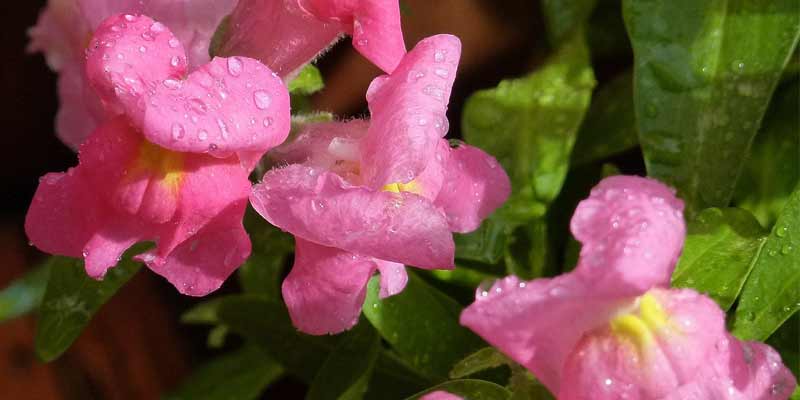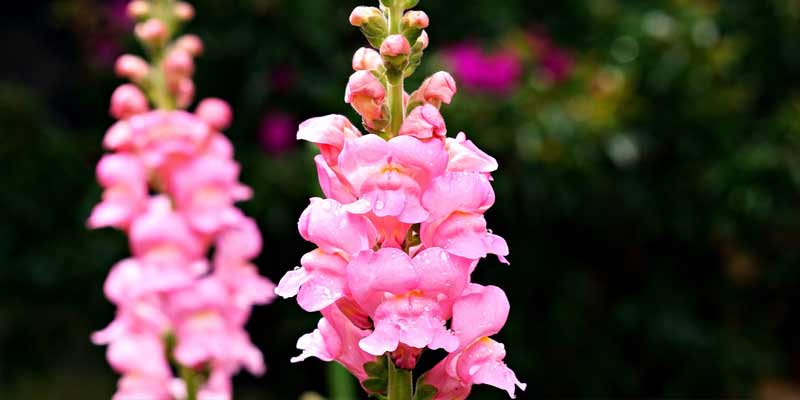With their whimsical blooms reminiscent of playful dragon faces, snapdragons, indeed, add not just a touch but an entire brushstroke of charm and color to any garden. These versatile flowers thrive across various climates; their resilience and beauty are widely cherished. Like all plants though—proper care is essential for them to flourish.
In this case, watering plays a particularly crucial role in determining health longevity. This comprehensive guide delves into the intricacies of watering snapdragons: we explore their frequency, technique, and common pitfalls to circumvent.
Understanding Snapdragons: A Brief Overview
Understanding the basic characteristics of snapdragons—botanically known as Antirrhinum, herbaceous perennials native to rocky areas in Europe, North America, and North Africa—is essential before delving into watering specifics. Belonging to the Plantaginaceae family; these plants are renowned for their distinctive flowers: tiny dragon heads that open and close when gently squeezed.
Depending on the climate, people typically cultivate snapdragons as annuals or short-lived perennials. These plants exhibit a variety of sizes: from compact dwarf varieties to towering specimens that may attain heights of several feet.
Bloom colors for snapdragons span an extensive range and include shades such as pink, red, yellow, purple white, and bicolor combinations; this diversity offers limitless potentiality in terms of garden design.
The Importance of Proper Watering
Snapdragons require water to maintain their health and vitality, as it perform numerous vital functions in the context of growth and development. The plant’s vigor and robustness hinge on adequate moisture for tasks such as nutrient uptake, photosynthesis, and cell expansion.
Stunted growth, wilting, and poor flowering can result from inadequate watering; conversely overwatering may instigate root rot, and fungal diseases – potentially leading to the death of the plant.
Understanding the specific needs of snapdragons and achieving a balanced watering regimen is key to successful gardening. Gardeners, by appropriately responding to these requirements, can foster healthy growth and abundant blooms throughout each growing season.
Determining Watering Frequency
“How often should I water my snapdragons?” ranks as one of the most prevalent questions among gardeners. The solution hinges on several factors: climate, soil type, container size (in the case of pot cultivation), and growth stage, which are all crucial determinants. Although snapdragons thrive in consistently moist soil; prolonged exposure to waterlogged conditions can induce susceptibility to root rot.
Generally, regular and deep watering proves more beneficial for snapdragons than frequent shallow irrigation. Aim to sufficiently penetrate the root zone with water, thereby promoting not only deep root growth but also drought tolerance.
A good rule of thumb, is when you touch the soil and it feels dry at the top inch, that’s when you should water your snapdragons. Depending on weather conditions and soil moisture retention, this may require a translation to watering once or twice per week.
In hot summer months or drought periods: snapdragons may demand more frequent watering to avert stress and wilting. Conversely, during cooler weather – or amid rainy spells; adjust the watering frequency correspondingly. Allow the soil a slight drying-out phase between each watering instance: this prevents waterlogged conditions.
Watering Techniques and Tips
To mitigate the risk of fungal diseases, ensure you apply water directly to the soil when watering snapdragons. Utilize a watering can, garden hose with a gentle spray attachment, or drip irrigation system for delivering water at the base of your plants; this method guarantees thorough coverage within their root zone.
Conserve Soil Moisture
To conserve soil moisture, suppress weeds, and regulate soil temperature around snapdragons: apply a layer of organic mulch such as shredded bark, straw, or compost. Ensure you leave a few inches of space around the stems to thwart issues related to excessive moisture.
Choosing The Right Pots
Select pots with drainage holes for your containers to avoid water accumulation at the bottom; opt for a well-draining potting mix specifically designed for flowering plants. Vigilantly monitor soil moisture levels: container mediums often dry out faster than garden beds – particularly in hotter weather conditions.
Minimize Water Loss
To minimize water loss through evaporation and mitigate the risk of fungal diseases, you should consider watering snapdragons in the early morning or late afternoon. However, avoid watering during midday heat; this could stress your plants and result in unnecessary water wastage.
Signs of Overwatering and Underwatering
To maintain the health and vigor of your snapdragons, it is crucial to monitor them for signs of overwatering or underwatering. Symptoms that may appear in overwatered snapdragons include yellowing leaves, wilting despite moist soil, and an unpleasant odor from the roots.
If you suspect overwatering, adjust your watering practices accordingly; allow a slight drying out of the soil before subsequent waterings.
On the other hand, underwatered snapdragons might exhibit wilted and drooping foliage as well as dry, crispy leaves.
Furthermore, their flowers could seem smaller and less vibrant than usual. Should your snapdragons present indicators of drought stress — water them deeply; mulch around their base to retain moisture will be beneficial.
Conclusion
To ensure the charm of your snapdragons’ blooms throughout the growing season, you must bestow upon them careful attention and an understanding of their specific needs. Providing consistent moisture, and avoiding waterlogged conditions – are imperative tasks; adjusting watering frequency based on environmental factors is equally crucial.
With proper care and attention lavished upon it, this delightful flower will continue to enchant gardeners, and admirers alike—for years to come.



Leave a Reply